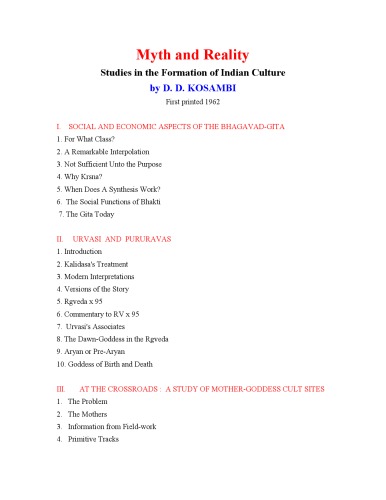Myth and Reality Studies in the Formation of Indian Culture 1st Edition by Damodar Dharmanand Kosambi ISBN 9789386042262 by D. D. Kosambi instant download after payment.
Myth and Reality Studies in the Formation of Indian Culture 1st Edition by Damodar Dharmanand Kosambi - Ebook PDF Instant Download/Delivery: 9789386042262
Full download Myth and Reality Studies in the Formation of Indian Culture 1st Edition after payment

Product details:
ISBN 13: 9789386042262
Author: Damodar Dharmanand Kosambi
This book is based on a profound study of literary sources and carefully planned fieldwork which throw fresh and novel light on the origins and development of Indian culture. Professor Damodar Dharmanand Kosambi has raised, analysed and solved questions of vital importance to all those interested in the study of Indology such as the data of Karle Caves; the background of Kalidasa’s plays; the significance of the great Pandharpur pilgrimage; and the economic, cultural and historical basis of the Goan struggle for union with India and others.
The work is most refreshing in its range of material as presented for the first time. The author makes an impressive use of scientific methods in many fields―archaeology, ethnography, philology and others. The logically consistent and intensely stimulating analyses and conclusions are often startling but always convincing and undeniably important as a landmark in the study of Indian tradition.
Myth and Reality Studies in the Formation of Indian Culture 1st Table of contents:
Part I: Social and Economic Aspects of the Bhagavad-Gita
- Chapter 1: For What Class?
- Examining the intended audience and social context of the Bhagavad-Gita.
- Chapter 2: A Remarkable Interpolation
- Analysis of key passages and potential later additions to the text.
- Chapter 3: Not Sufficient Unto the Purpose
- Critique of the Gita's practical application in different historical periods.
- Chapter 4: Why Krishna?
- Tracing the historical and cultural evolution of Krishna's role.
- Chapter 5: When Does a Synthesis Work?
- Exploring the synthesis of different philosophical and social ideas within the Gita.
- Chapter 6: The Social Functions of Bhakti
- The role of devotion (bhakti) in consolidating social structures.
- Chapter 7: The Gita Today
- The enduring relevance and interpretations of the Bhagavad-Gita in contemporary India.
Part II: Urvashi and Pururavas
- Chapter 1: Introduction
- Setting the stage for the ancient Indian myth of Urvashi and Pururavas.
- Chapter 2: Kalidasa's Treatment
- Analysis of Kalidasa's play Vikramorvashiyam and its portrayal of the myth.
- Chapter 3: Modern Interpretations
- Various modern scholarly and popular interpretations of the myth.
- Chapter 4: Versions of the Story
- Comparative study of different versions of the Urvashi-Pururavas narrative across texts.
- Chapter 5: Rigveda X.95
- Detailed examination of the Vedic hymn (Rigveda 10.95) as the earliest known source.
- Chapter 6: Commentary to Rigveda X.95
- Scholarly commentaries and their implications for understanding the hymn.
- Chapter 7: Urvashi's Associates
- Exploring other figures associated with Urvashi in various myths.
- Chapter 8: The Dawn-Goddess in the Rigveda
- Connections between Urvashi and the Vedic dawn goddess Ushas.
- Chapter 9: Aryan or Pre-Aryan?
- Debate on the origins of the myth – whether it's Indo-Aryan or has pre-Aryan roots.
- Chapter 10: Goddess of Birth and Death
- Analyzing Urvashi's symbolic significance related to fertility, life, and mortality.
Part III: At the Crossroads: A Study of Mother-Goddess Cult Sites
- Chapter 1: Introduction
- The significance of mother-goddess cults in Indian prehistory and history.
- Chapter 2: The Data of Karle Caves
- Archaeological and epigraphic evidence from the Buddhist caves at Karle.
- Chapter 3: The Background of Kalidasa's Plays
- How ancient cults and social practices are reflected in classical Sanskrit literature.
- Chapter 4: The Significance of the Great Pandharpur Pilgrimage
- Connecting ancient local cults to major pilgrimage traditions.
- Chapter 5: The Trade Routes
- The role of ancient trade routes in the spread of cults and cultural ideas.
- Chapter 6: The Jatakas
- Insights from Jataka tales into popular beliefs and practices.
- Chapter 7: Carudatta's Sacrifice
- Analyzing specific rituals or narratives from literary sources to understand social customs.
Part IV: Pilgrim's Progress: A Contribution to the Prehistory of the Western Deccan Plateau
- Chapter 1: The End of Prehistory in the Deccan
- Transition from prehistoric to historical periods in the Western Deccan.
- Chapter 2: Cult Migrations: The Goddesses and Megaliths
- Tracking the movement of goddess cults and their association with megalithic sites.
- Chapter 3: Cult Migrations: The Gods
- The diffusion of male deities and their connection to specific regions.
- Chapter 4: Microlith Tracks
- Evidence from microlithic tools indicating ancient migratory patterns.
- Chapter 5: Highlanders and Laplanders
- Comparative analysis of tribal groups and their cultural practices.
- Chapter 6: Later Developments
- Evolution of cults and social structures over time.
- Chapter 7: Towards Agriculture
- The impact of the agricultural revolution on early Indian society and culture.
Part V: The Village Community in the 'Old Conquests' of Goa
- Chapter 1: Land and People
- Geographical and demographic characteristics of the Goan region.
- Chapter 2: The Economic Situation
- Economic structures and land-holding patterns in the 'Old Conquests'.
- Chapter 3: Heterogeneity of the Population
- Diversity of communities and their interactions.
- Chapter 4: The Feudal Period
- Analysis of feudal structures and their impact on village life.
- Chapter 5: Introduction (to this part)
- (Often a brief overview of the essays in this section)
People also search for Myth and Reality Studies in the Formation of Indian Culture 1st:
myth and reality studies in the formation of indian culture
myth vs reality examples
myth and reality meaning
why is a backstory important in a myth
myth and reality
Tags: Damodar Dharmanand Kosambi, Myth, Reality



